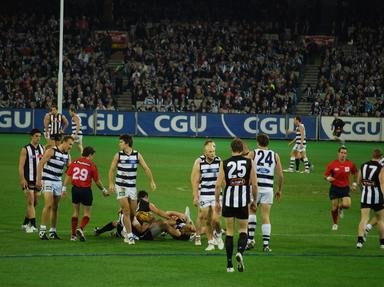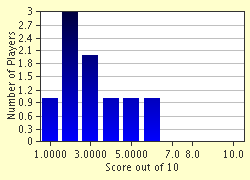Quiz Answer Key and Fun Facts
1. Melbourne tried a desperate ploy in the 1948 finals series, bringing retired stars Jack Mueller and Norm Smith out of retirement. This worked spectacularly, with both players, particularly Mueller, dominating the finals and ultimately leading Melbourne to an unlikely premiership. How many goals did Mueller kick in the three games he played in the finals series?
2. The nail-biting 1943 Grand Final between Essendon and Richmond culminated in a frantic last quarter struggle which Richmond star Jack Dyer dominated and a last ditch effort from the Bombers that fell metres short as the Tigers triumphed by 5 points. However, the most exciting thing in this match was a shootout between two star forwards who each kicked 7 goals for their respective teams. Who were these two star goalkickers?
3. The first quarter of the 1946 Grand Final between Melbourne and Essendon could only be described as obscenely high-scoring. With both teams' defences barely to be seen, it was the highest-scoring quarter in a Grand Final by a mile. What was the score at quarter time, with Melbourne having the slight edge by 7 points?
4. Throughout the 1940s, just four teams won the wooden spoon. What were these four teams who shared this honour, generously?
5. The 1940s was the time of World War 2, and many football players enlisted for the army, as they were fit, young and strong. This caused the Brownlow Medal to be suspended for several years. After being stopped after 1941, in what year did it return?
6. In Round 13, 1944, South Melbourne kicked one of the most inaccurate scores in history, despite winning by 22 points against Geelong. What was South's final score?
7. With four minutes to go in the first semi final of 1946, Footscray led by 7 points, and looked to have the game in the bag against Melbourne, when a dubious mark was paid to a Footscray player very close to goal. Much to the chagrin of the Footscray faithful, he skewed the kick, as his leg buckled from underneath him and the ball trickled out of bounds. Who was this star ruckman?
8. Recruited by Richmond from Kew, he played in the 1943 Grand Final against Essendon. He was placed on Essendon star Dick Reynolds (who was also his cousin) and curbed Reynolds' influence well, which led to a Richmond win. Who is the player, who played 162 more games for Richmond until 1954?
9. Kicking 26 goals, this talented Collingwood forward made a brief but solid impact in his 8 games with the Pies in 1944, including 8 goals in one game against Geelong. Who was this enigmatic player?
10. Kicking 9 goals on a losing side is a rare event. Gary Ablett snr was the second, when he kicked 9 against Hawthorn in the 1989 Grand Final. Who was the first to do this - for South Melbourne against Essendon in the 1942 preliminary final?
Source: Author
zoomba23
This quiz was reviewed by FunTrivia editor
gtho4 before going online.
Any errors found in FunTrivia content are routinely corrected through our feedback system.

